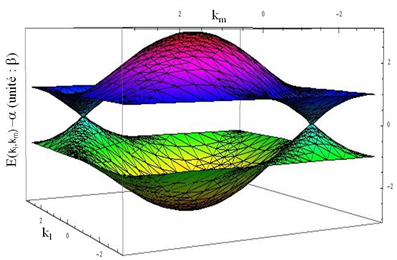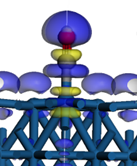Niveau d'étude
BAC +4
ECTS
5 crédits
Composante
Faculté des Sciences
Description

Wavefunction of an excited electron trapped in a cubic box: model for a quantum dot state
- Introduction to basic concepts in quantum physics and its relation to chemistry, modern materials science and engineering of nanodevices.
- To achieve the goals of this course, a mathematically-rigorous approach is combined with the physical interpretation of the concepts, and the application of the most important QM models to electronic and magnetic spectroscopies and chemistry is illustrated.
Volumes horaires* :
CM (Lectures) : 24H
TD (Tutorials) : 12H
Objectifs
At the end of the course, the student should attain:
- a real understanding of the quantum nature of matter; introduction to simple models in quantum mechanics.
- a real understanding of the theoretical formalism used to describe quantum phenomena, which is needed for the characterization and engineering of materials.
- in-depth knowledge of electronic states; quantum numbers, electronic transitions and their relation to spectroscopy; electronic states in electric and magnetic fields.
- the necessary background for further learning of computational modeling methods and advanced techniques applicable to the elucidation of electronic and geometrical structures, as well as the spectroscopic properties of materials.
Pré-requis nécessaires
Differential calculus. Matrix algebra. A knowledge of crystallography,
Contrôle des connaissances
CCI
Syllabus

Electronic band structure of a Graphene sheet for nanomaterials
Quantum Mechanics and Modelling
1 Quantum Mechanics: Mathematical Background
1.1 Postulates of Quantum Mechanics
1.2 Operators
1.3 Eigenfunctions and eigenvalues
2 The Schrodinger Equation
2.1 Historical background
2.2 The Uncertainty Principle
2.3 The Time Dependent Schrodinger Equation
2.4 The Time Independent Schrodinger Equation
3 Classical 1-particle quantum models
3.1 Translational motion: application to electronic microscoscopy
3.2 Particle in a 1D box
-quantum confinement and zero-point energy
3.3 Particle in a rectangular well:
-application to quantum dots and F-centers physics
3.4 Potential barriers and tunneling
-application to scanning tunneling microscopy (STM)
3.5 The harmonic oscillator
-application to molecular vibration
3.6 Particle on a ring
-introduction to angular momentum
3.7 Particle on a sphere
-application to molecular rotation
4 Angular Momentum
4.1 The Angular Momentum Operators
4.2 Eigenvalues and Eigenfunctions of the Angular Momentum
4.3 Spin
4.4 The Angular Momenta of Composite Systems
4.5 Coupling of Several Angular Momenta
4.6 The Conservation of Angular Momentum
5 Techniques of Approximation
5.1 Time-Independent Perturbation Theory
5.2 Variation Theory
6 Atomic Structure
6.1 The Spectrum of Atomic Hydrogen
6.2 Spin: Fine Structure and Spin-Orbit Coupling
6.3 Pauli Principle
6.4 Structure and Spectrum of the Helium Atom
6.5 Approximate Atomic Orbitals: Self-Consistent Fields and HF Equations
6.6 Correlated Electronic Motion
6.7 Selection Rules

Respose properties of a CO molecule poisoning a fuel cell catalyst surfacen
Bibliographie
Références :
- R. C. Greenhow, Introductory Quantum Mechanics, Hilger, Brisot, New York, ESM, Cambridge, 1990 .
- David Griffiths, Introduction to Quantum Mechanics, Pearson New International edition , London (first and second editions)

